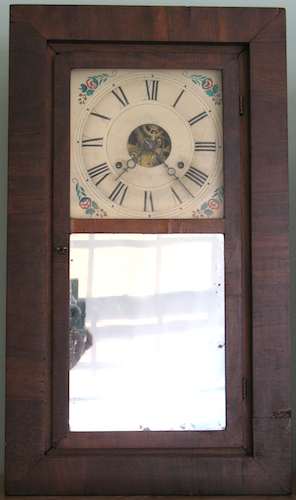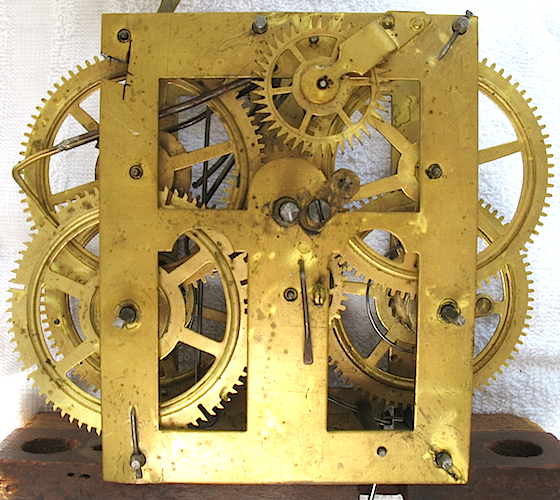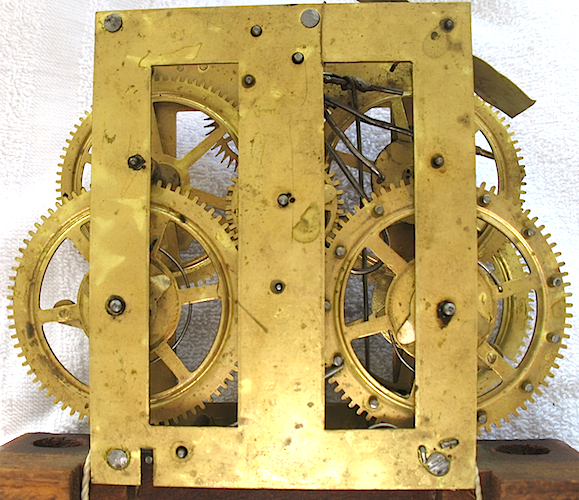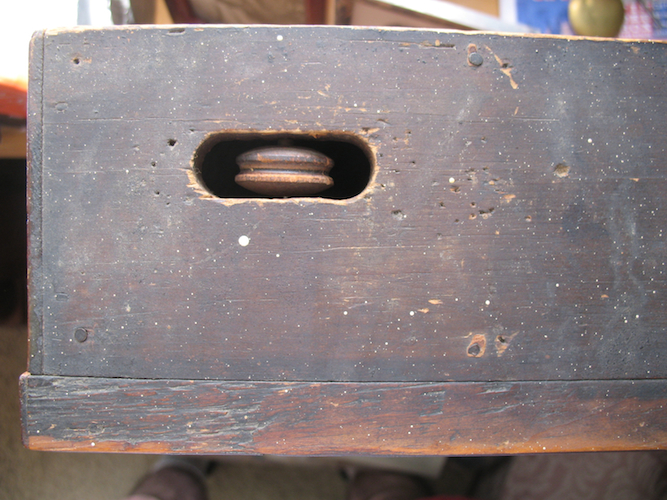This 30-hr, weight-driven clock with flat moulded case dates to around 1841. In a modest sense, it testifies to Jerome’s unending experimentation with new styles and construction techniques. As little more than a rectangular box to house the movement, it shares a lot with the ubiquitous and popular ogee, as well as the less common flat front case. Compared to the dimensions of a typical ogee from the same period at 15 1/2″ x 25 7/8″, though, this clock is smaller (14″ x 24 3/8″). As noted by Chris Bailey in “Rags to Riches to Rags,” the front is a separate unit that was attached to the box (see detail below), a technique used by Jerome in his 1857 patent case. The dial is old and has been repainted, but, based on unused screw holes, it is not original to the clock. The hands are also replacements. The upper glass is original, and the mirror may be. If it is not, it is a very old replacement, as the putty is virtually indistinguishable from the putty used for the upper glass and is of the period. Other examples of this style of clock that I’ve seen have reverse-painted tablets with typical early 1840s landscapes with a prominent mansion. The clocks had the following combinations of dials and upper glass: 1) brass dial with raised chapter ring and black numerals and reverse-painted glass with spandrels in the corners; and 2) white-painted zinc dial with raised chapter ring and floral decorations in the corners and clear glass.
The label was printed by Elihu Geer at 26 ½ State St., Hartford, CT. Although not clearly visible on this label due to loss, the corner blocks feature representations of Veronica’s veil and Holy Communion (see this ogee for a better example). All examples of this clock I’ve seen have the same label. Including other case styles, this label, which I believe to be the first used by Jerome after he became sole owner of the company, is associated with the following movements, in order of production: type 1.114 (possibly not original), type 1.211 (wide wheels, unstamped), type 1.211 (wide wheels, stamps in the 3000s), type 1.211 (normal wheels, stamps in the 4000s-10000s), and type 1.211 (normal wheels, unstamped). There are three other labels associated with serial numbered movements, but the serial numbers in each of these span a much narrower range. The label in this clock covers the entire range of type 1.211s, from introduction of the wide-wheeled version, through the entire serial number range (3000s-10000s), and into the unstamped, normal-wheeled type 1.211s. Based on the number of different labels used by Jerome from 1838-1844 (the Bristol years), a particular label would have been in use for slightly over a month-and-a-half (on average).
Front view of the type 1.211, 30-hr movement (normal-wheeled variant). This version is unstamped. The movement has experienced some butchery over the years. Notice the cutout near the fly arbor in the upper left. The count hook has had a new hook soldered on. The trip wire no longer hangs from the count hook. It is now attached to one of the other strike levers (as seen in view from rear). Of the other examples I’ve come across, one has a stamp with serial number 7869, and the others are unstamped (normal-wheeled).
Rear view of the type 1.211 movement.
Detail of the top of the case, showing the box with attached front.




